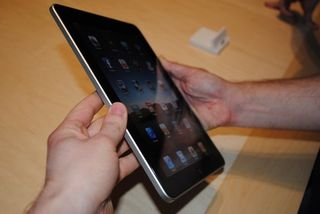11 Features Other Tablets Can Use to Flatten the iPad

The iPad is obviously not the first slate tablet in existence, though some rabid fans and journalists seem to think otherwise. With its $499 starting price, huge app ecosystem, attractive looks, and fast processor, can anyone stop the iPad from dominating the tablet world like the iPod dominates the PMP market? You bet they can!
After we did our hands-on with the iPad this afternoon, we were impressed with the device's blazing performance and beautiful touch interface, but we also noticed several ways it falls short. If other vendors seize the opportunity to include most if not all of these 11 features into their devices--while delivering a good touch UI--they'll have a shot at stealing Apple's thunder.
1. Higher-Resolution Screens: The iPad's 9.7-inch screen displays content at a mere 1024 x 768, 168 pixels more than the average 10-inch netbook, but not nearly enough. The Lenovo IdeaPad U1 Hybrid offers a full 1366 x 768 resolution, a step above 720p and enough to see more of your Web pages or photos.
2. A Complete Desktop OS: While some tablet users prefer the scaled-back functionality of a phone OS like the iPhone OS or Google Android, many people want the security and familiarity of a mainstream OS that runs all their desktop apps. With low-power CPUs like the Intel Atom Z series or Nvidia's Tegra platform it's more than possible to create a compelling Windows 7 tablet.
3. Dual Screens: CES was buzzing about MSI's dual screen tablet prototype and for good reason. Who doesn't want a device where one screen can be used as a keyboard or where the whole system can fold in half and fit in a coat pocket?
4. Full HD Output: There's no HDMI port on the iPad and, according to Apple's site, the best resolution it can output to an external screen is 576p (720 x 704). One of the main use cases of any tablet is for entertainment, but if you buy movies for your tablet, you should be able to output them straight to your TV. Even better than HDMI would be a wireless display technology like Intel's WiDi or the 1080p-caable WHDI.
5. Camera(s). We were hoping the iPad would come with front-facing a webcam for video chats or a back-facing camera for taking pictures. Some even predicted it would have both. Alas, the iPad is camera-less. Tablets should have a webcam for chatting at least; a back-facing camera would be great for augmented reality apps as well as photos.
Stay in the know with Laptop Mag
Get our in-depth reviews, helpful tips, great deals, and the biggest news stories delivered to your inbox.
6. A Robust Dock. Seeing that the iPad already has a dock and keyboard accessory caused many to breathe a sigh of relief, especially when looking at the promised functionality of iWork. Still, a dock that does more with a better eye toward portability would be even better. The lack of ports could be alleviated by a good dock with all the connections users have come to expect on notebooks (or, at least, netbooks). We like Lenovo’s IdeaPad U1 so much because the dock is essentially the other half of a notebook, allowing for the portability and ease of a slate and the convenience of a netbook in one package. Not all docks need to go to the same;level, they just need to offer a decent number of options.
7. Multitasking. This is one area where all Android tablets have the iPad beat out of the gate. The ability to run multiple programs at once is a pretty basic requirement for a computer-like device, even a tablet. Tablets running the aforementioned Android plus those few that run windows (like the Archos 9) and any that run other flavors of Linux have multitasking built in. Even iPhone owners have long wished for this ability.
8. Browser Flash Support. At least the iPad isn’t alone here – Android tablets face the same lack of support for Flash in the native browser. It’s not just about video content, either. The Web is chock full of Flash and tablets need to support it if they claim to put all the wonders of the Internet at our fingertips.
9. USB Ports: Every device needs at least one USB port, though we like the one full-size and one mini combination we last saw on the Camangi WebStation. There’s a reason every computer comes with these now. Not only are they useful for connecting peripherals and accessories but also external drives and flash memory. Allowing a tablet to charge via USB, like a smart phone, is a huge plus.
10. A Memory Card Reader: Though Apple may feel that the Camera Connection Kit is satisfactory, many would appreciate an integrated reader that doesn’t require us to carry several extra connectors just in case.
11. Haptic Feedback: Most Android phones already support haptic feedback, which can make a virtual button feel like a physical one. The keyboard on the MSI dual screen tablet prototype even has adjustable levels of feedback that gave the keys a nice tactile feel. If you want users to type on screen, it helps to give them a more realistic typing experience.
The tablet race has just begun and, while Apple has made a compelling product, the press it has received may actually help some competitors by bringing more attention to the tablet category. If vendors listen to their customers, they may be able to create something even stronger.
